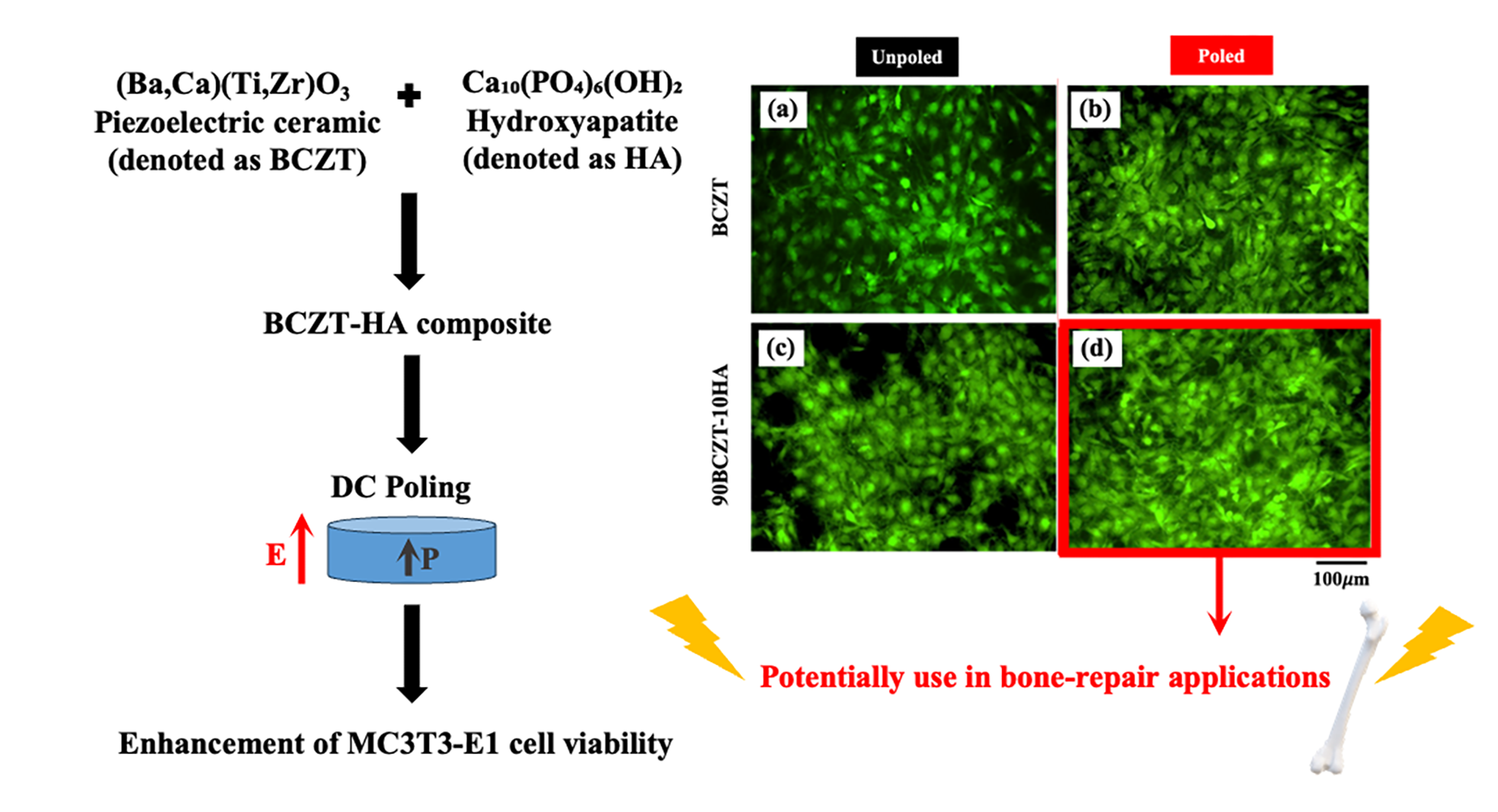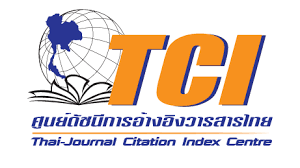Enhancement of cell viability of the (Ba,Ca)(Zr,Ti)O\(_{3}\) and hydroxyapatite composites for bone-repair applications
DOI:
https://doi.org/10.55713/jmmm.v35i1.2153Keywords:
Bone Tissue Engineering, Bone-repair applications, Lead-free piezoceramics, Barium Titanate, HydroxyapatiteAbstract
In this work, the influence of hydroxyapatite (HA) addition to the calcium/zirconium-doped barium titanate (BCZT) piezoceramic was investigated to evaluate its potential for bone-repair applications. The relationship between the physical, electrical, and biological properties of the (100-x)BCZT-(x)HA composite was observed via various techniques. The HA powder was synthesized via precipitation method, whereas the BCZT powder was produced by solid-state reaction to prepare the (100-x)BCZT-(x)HA composites, where x = 0 wt% to 50 wt%. The results showed that the dielectric, ferroelectric, and piezoelectric properties of the (100-x)BCZT-(x)HA composites decreased dramatically as introducing HA into BCZT due to the occurrence of secondary phases from the reactivity between BCZT and HA during sintering. However, although the addition of 10wt%HA into BCZT caused a significant drop of its electrical properties, the enhancement of MC3T3-E1 cell viability was found. Moreover, this work demonstrates for the first time that the number of viable cells observed in the poled 90BCZT-10HA ceramics was significantly higher than that observed in the unpoled BCZT ceramics. These results suggest that the BCZT-HA composite has potential for use in bone-repair applications.
Downloads
References
E. Fukuda, and I. Yasuda, "On the piezoelectric of bone," Journal of Physical Societry of Japan, vol. 12, pp. 1158-1162, 1957. DOI: https://doi.org/10.1143/JPSJ.12.1158
A. B. M. Braden, I. Beider, and B.G Ritter, "Electrical and piezo-electrical properties of dental hard tissues," Nature, vol. 212, pp. 1565-1566, 1966. DOI: https://doi.org/10.1038/2121565a0
F. R. Baxter, C. R. Bowen, I. G. Turner, and A. C. Dent, "Electrically active bioceramics: a review of interfacial responses," Annals of Biomedical Engineering, vol. 38, no. 6, pp. 2079-2092, 2010. DOI: https://doi.org/10.1007/s10439-010-9977-6
A. Blázquez-Castro, A. García-Cabañes, and M. Carrascosa, "Biological applications of ferroelectric materials," Applied Physics Reviews, vol. 5, no. 4, p. 41101, 2018. DOI: https://doi.org/10.1063/1.5044472
J. B. Park, A. F. v. Recum, G. H. Kenner, B. J. Kelly, W. W. Coffeen, and M. F. Grether, "Piezoelectric ceramic implants: a feasibility study," Journal of Biomedical Materials Research, vol. 15, pp. 103-110, 1981. DOI: https://doi.org/10.1002/jbm.820150114
K. K. Poon, M. C. Wurm, D. M. Evans, M. A. Einarsrud, R. Lutz, and J. Glaum, "Biocompatibility of (Ba,Ca)(Zr,Ti)O3 piezoelectric ceramics for bone replacement materials," Journal of Biomedical Materials Research Part B: Applied Biomaterials, vol. 108, no. 4, pp. 1295-1303, 2020. DOI: https://doi.org/10.1002/jbm.b.34477
W. Liu, and X. Ren, "Large piezoelectric effect in Pb-free ceramics," Physical Review Letters, vol. 103, no. 25, p. 257602, 2009. DOI: https://doi.org/10.1103/PhysRevLett.103.257602
W. Chen, Z. Yu, J. Pang, P. Yu, G. Tan, and C. Ning, "Fabrication of biocompatible potassium sodium niobate piezoelectric ceramic as an electroactive implant," Materials (Basel), vol. 10, no. 4, p. 345, 2017. DOI: https://doi.org/10.3390/ma10040345
J. A. Hermann-Muñoz, J. A. Rincón-López, D. A. Fernández-Benavides, R. Detsch, J.M. Alvarado-Orozco, A. R. Boccaccini, and J. Muñoz-Saldaña, "In-vitro bioactivity and cytotoxicity of polarized (Bi0.5Na0.5)TiO3 ceramics as a novel biomaterial for bone repair," Materials Letters, vol. 275, p. 128078, 2020. DOI: https://doi.org/10.1016/j.matlet.2020.128078
S. Nakamura, H. Takeda, and K. Yamashita, "Proton transport polarization and depolarization of hydroxyapatite ceramics," Journal of Applied Physics, vol. 89, no. 10, pp. 5386-5392, 2001. DOI: https://doi.org/10.1063/1.1357783
K. Lin, and J. Chang, "1 - Structure and properties of hydroxy-apatite for biomedical applications," in Hydroxyapatite (Hap) for Biomedical Applications, M. Mucalo Ed.: Woodhead Publishing, 2015, pp. 3-19. DOI: https://doi.org/10.1016/B978-1-78242-033-0.00001-8
S. N. T. Kobayashi, and K. Yamashita, "Enhanced osteobonding by negative surface charges of electrically polarized hydroxy-apatite," Journal of Biomedical Materials Research, vol. 59, no. 3, pp. 477-484, 2002. DOI: https://doi.org/10.1002/1097-4636(20011215)57:4<477::AID-JBM1193>3.0.CO;2-5
T. K. M. Ohgaki, M. Katsura, and K. Yamashita, "Manipulation of selective cell adhesion and growth by surface charges of electrically polarized hydroxyapatite," Journal of Biomedical Materials Research, vol. 57, no. 3, pp. 366-373, 2001. DOI: https://doi.org/10.1002/1097-4636(20011205)57:3<366::AID-JBM1179>3.0.CO;2-X
S. Bodhak, S. Bose, and A. Bandyopadhyay, "Electrically polarized HAp-coated Ti: In vitro bone cell–material interactions," Acta Biomaterialia, vol. 6, no. 2, pp. 641-651, 2010. DOI: https://doi.org/10.1016/j.actbio.2009.08.008
S. Manohar, S. K. Belliraj, S. P. Sadhu, S. K. S. Bhagavatham, S. Muthukumar, S. Venketesh, and K. Varma, "Novel Lead-free biocompatible piezoelectric Hydroxyapatite (HA) – BCZT (Ba0.85 Ca0.15Zr0.1Ti0.9O3) nanocrystal composites for bone regeneration," Nanotechnology Reviews, vol. 8, no. 1, pp. 61-78, 2019. DOI: https://doi.org/10.1515/ntrev-2019-0006
M. Prakasam, M. Albino, E. Lebraud, M. Maglione, C. Elissalde, and A. Largeteau, "Hydroxyapatite-barium titanate piezo-composites with enhanced electrical properties," Journal of the American Ceramic Society, vol. 100, no. 6, pp. 2621-2631, 2017. DOI: https://doi.org/10.1111/jace.14801
Y. Tang, C. Wu, Z. Wu, L. Hu, W. Zhang, and K. Zhao, "Fabrication and in vitro biological properties of piezoelectric bioceramics for bone regeneration," Scientific Reports, vol. 7, p. 43360, 2017. DOI: https://doi.org/10.1038/srep43360
T. Tariverdian, A. Behnamghader, P. Brouki Milan, H. Barzegar-Bafrooei, and M. Mozafari, "3D-printed barium strontium titanate-based piezoelectric scaffolds for bone tissue engineering," Ceramics International, vol. 45, no. 11, pp. 14029-14038, 2019. DOI: https://doi.org/10.1016/j.ceramint.2019.04.102
F. J. Vouilloz, M. S. Castro, G. E. Vargas, A. Gorustovich, and M. A. Fanovich, "Reactivity of BaTiO3-Ca10(PO4)6(OH)2 phases in composite materials for biomedical applications," Ceramics International, vol. 43, no. 5, pp. 4212-4221, 2017. DOI: https://doi.org/10.1016/j.ceramint.2016.12.053
B. Ozcelik, C. Ergun, and H. Liu, "A study on calcium phosphate/ barium titanate composites: phase characterization, piezoelectric property, and cytocompatibility," Journal of the Australian Ceramic Society, vol. 56, no. 4, pp. 1197-1216, 2020. DOI: https://doi.org/10.1007/s41779-020-00468-y
N. Koju, P. Sikder, B. Gaihre, and B. B. S, " Smart injectable self-setting monetite based bioceramics for orthopedic applications," Materials (Basel), vol. 11, no. 7, p. 1258, 2018. DOI: https://doi.org/10.3390/ma11071258
B. Tandon, J. J. Blaker, and S. H. Cartmell, "Piezoelectric materials as stimulatory biomedical materials and scaffolds for bone repair," Acta Biomaterialia, vol. 73, pp. 1-20, 2018. DOI: https://doi.org/10.1016/j.actbio.2018.04.026
A. Z. Khalf, and D. A. Hall, "Influence of barium borosilicate glass on microstructure and dielectric properties of (Ba,Ca) (Zr,Ti)O3 ceramics," Journal of the European Ceramic Society, vol. 38, no. 13, pp. 4422-4432, 2018. DOI: https://doi.org/10.1016/j.jeurceramsoc.2018.06.008
C. Chen, H. Zhuang, X. Zhu, D. Zhang, K. Zhou, and H. Yan, "Effect of Ca substitution sites on dielectric properties and relaxor behavior of Ca doped barium strontium titanate ceramics," Journal of Materials Science: Materials in Electronics, vol. 26, no. 4, pp. 2486-2492, 2015. DOI: https://doi.org/10.1007/s10854-015-2710-3
D. E. Newbury, "Mistakes encountered during automatic peak identification of minor and trace constituents in electron-excited energy dispersive X-ray microanalysis," Scanning, vol. 31, no. 3, pp. 91-101, 2009. DOI: https://doi.org/10.1002/sca.20151
L. E. Cross, "Relaxor ferroelectrics," Ferroelectrics, vol. 76, no. 1, pp. 241-267,1987. DOI: https://doi.org/10.1080/00150198708016945
D. Khare, B. Basu, and A. K. Dubey, "Electrical stimulation and piezoelectric biomaterials for bone tissue engineering applications," Biomaterials, vol. 258, p. 120280, 2020.
D. Damjanovic, "Ferroelectric, dielectric and piezoelectric properties of ferroelectric thin films and ceramics," Reports on Progress in Physics, vol. 61, no. 9, pp. 1267-1324, 1998. DOI: https://doi.org/10.1088/0034-4885/61/9/002
K. H. Härdtl, "Electrical and mechanical losses in ferroelectric ceramics," Ceramics International, vol. 8, no. 4, pp. 121-127, 1982. DOI: https://doi.org/10.1016/0272-8842(82)90001-3
F. R. Baxter, I. G. Turner, C. R. Bowen, J. P. Gittings, and J. B. Chaudhuri, "An in vitro study of electrically active hydroxy-apatite-barium titanate ceramics using Saos-2 cells," Journal of Materials Science: Materials in Medicine, vol. 20, no. 8, pp. 1697-708, 2009. DOI: https://doi.org/10.1007/s10856-009-3734-0
J. Rödel, W. Jo, K. T. P. Seifert, E.-M. Anton, T. Granzow, and D. Damjanovic, "Perspective on the development of lead-free piezoceramics," Journal of the American Ceramic Society, vol. 92, no. 6, pp. 1153-1177, 2009. DOI: https://doi.org/10.1111/j.1551-2916.2009.03061.x
A. Carter, K. Popowski, K. Cheng, A. Greenbaum, F. S. Ligler, and A. Moatti, "Enhancement of bone regeneration through the converse piezoelectric effect, a novel approach for applying mechanical stimulation," Bioelectricity, vol. 3, no. 4, pp. 255-271, 2021. DOI: https://doi.org/10.1089/bioe.2021.0019
S. Lavenus, P. Pilet, J. Guicheux, P. Weiss, G. Louarn, and P. Layrolle, "Behaviour of mesenchymal stem cells, fibroblasts and osteoblasts on smooth surfaces," Acta Biomaterialia, vol. 7, no. 4, pp. 1525-1534, 2011. DOI: https://doi.org/10.1016/j.actbio.2010.12.033
A. W. Adamson, Physical Chemistry of Surfaces, 6th Edition ed. Wiley, 1997, p. 808.
S. R. Paital, and N. B. Dahotre, "Wettability and kinetics of hydroxyapatite precipitation on a laser-textured Ca-P bioceramic coating," Acta Biomaterialia, vol. 5, no. 7, pp. 2763-72, 2009. DOI: https://doi.org/10.1016/j.actbio.2009.03.004

Downloads
Published
How to Cite
License
Copyright (c) 2025 Journal of Metals, Materials and Minerals

This work is licensed under a Creative Commons Attribution-NonCommercial-NoDerivatives 4.0 International License.
Authors who publish in this journal agree to the following terms:
- Authors retain copyright and grant the journal right of first publication with the work simultaneously licensed under a Creative Commons Attribution License that allows others to share the work with an acknowledgment of the work's authorship and initial publication in this journal.
- Authors are able to enter into separate, additional contractual arrangements for the non-exclusive distribution of the journal's published version of the work (e.g., post it to an institutional repository or publish it in a book), with an acknowledgment of its initial publication in this journal.












